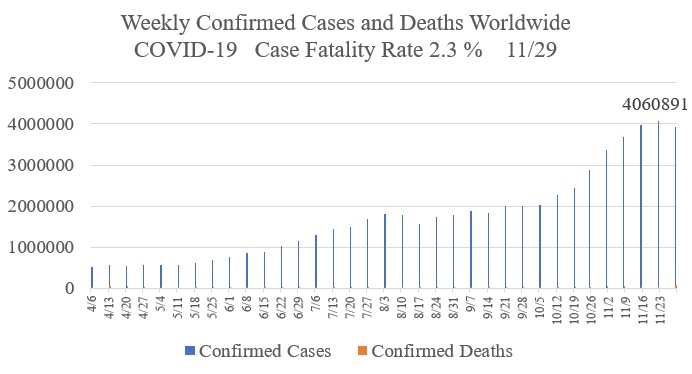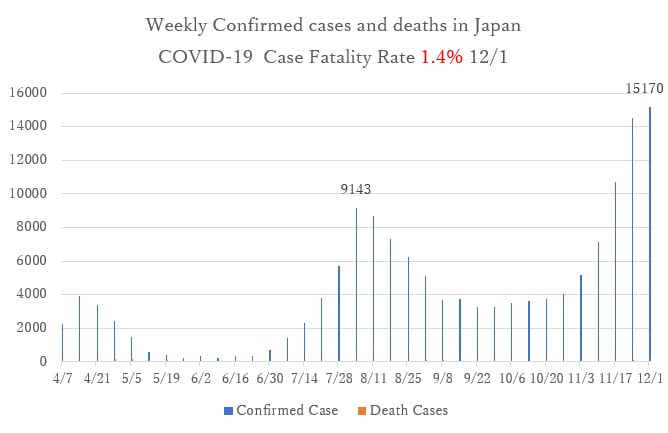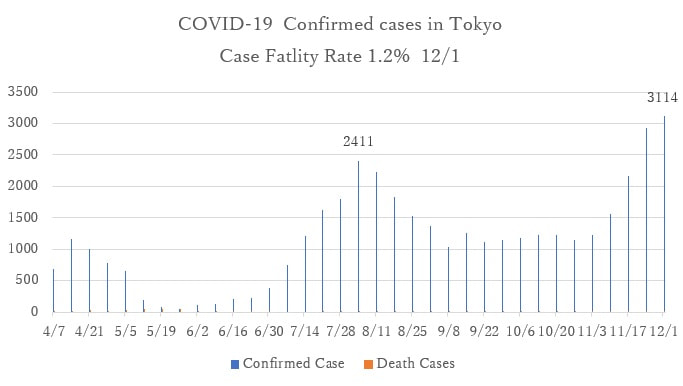SHARE
Services for the Health in Asian & African Regions (SHARE) = SHARE is a citizen sector organization (NGO) that engages in international cooperation mainly through providing health service.
HOME > News > Information of COVID-19(13)
- 【※updated】COVID-19(multi-language)
- Information of COVID-19(15)
- Information of COVID-19(vaccines)
- 《Request to the Government of Japan》Ease the protection of intellectual property rights and promote sharing and cooperating on pharmaceuticals and medical technologies, in order to accelerate efforts to overcome COVID-19 all over the world.
- Information of COVID-19(14)
- Information of COVID-19(13)
- Information of COVID-19(12)
- Information of COVID-19(11)
- SHARE Medical Information Line for Migrants is resumed in Oct.
- Information of COVID-19(10)
Information of COVID-19(13)

Information of COVID-19 (13)by SHARE 2020.12.3
1. Global and Japanese Situation regarding COVID-19
■Confirmed cases and new deaths from COVID-19 worldwide(source: WHO, updated 2020/11/29)Case fatality rate:2.4%

- Worldwide, the number of new positive cases every day is about 4 million, and there are more than 53.7 million total positive cases and 1.3 million total deaths, with a fatality rate of 2.4%. (WHO, updated 2020/11/22)
- Globally, the number of new positive cases per week has increased in Europe and the Americas, which accounts for 80% of new cases. While the rate of increase is high and growing in the Americas, there has been a decrease in the rate of increase in the European region due to the strengthening of public health measures.
- In the Eastern Mediterranean, African and Western Pacific regions, there is an increasing trend of the number of new cases.
- In the Southwest Asia region, including India, one of the endemic countries, the number of cases is on the decline.
- The numbers of new cases for select countries during the week of November 9-15 were: In the Americas, 1 million in the United States and 180,000 in Brazil; in Europe, 240,000 in Italy and 200,000 in France; in Southwest Asia, 300,000 in India; in the Mediterranean, 76,000 in Iran, 36,000 in Jordan, and 36,000 in Morocco; in Africa, 13,000 in South Africa; and in the Western Pacific region, 13,000 in the Philippines. The outbreak of COVID-19 in the United States stands out.
- The WHO held an extraordinary general meeting from November 9 to 14 to discuss future efforts for the countermeasures against COVID-19.
■Weekly confirmed cases and deaths of COVID-19 in Japan (updated 2020/12/1)
- Case fatality rate 1.4%

■Weekly confirmed cases of COVID-19 in Tokyo(updated 2020/12/1)
- Case fatality rate 1.2%

- The number of new positive cases has increased since late October. While an increase in the Tokyo metropolitan area has been seen, the number of new cases also has increased in Hokkaido, Osaka, and Aichi, leading to a nationwide increase in COVID-19 infection. The third wave of epidemic is observed.
- The places which have clusters of cases that cause the spread of the COVID-19 in the community have diversified, including dining places, workplaces, foreign resident communities, medical institutions, and welfare facilities, in addition to the orthodox cluster places such as entertainment areas of local cities. The likely causes of the outbreaks are the increase of domestic migration of people using the Go To Travel and Go To Eat campaigns and the tourism activities during the fall holiday season.
- The number of positive cases of foreigners detected at airport quarantine is also increasing. The possibility that the outbreak among foreign resident communities in Japan may be due to the infection from newly arrived members in the communities cannot be ruled out.
2. Two Effective COVID-19 Vaccines
U.S. Pfizer Inc.- On November 20, Pfizer Inc. from the US and BioNTech from Germany announced that they have submitted a request to the U.S. Food and Drug Adminisitation (FDA) for an Emergency Use Authorization (EUA) of their COVID-19 vaccine candidate.
- Pfizer Inc. announced earlier this week that the final analysis of clinical trial data showed that the vaccine is effective in preventing new coronavirus (SARS-CoV-2) infections with a 95 percent chance of success. The company said It is effective across all age groups of adults and ethnicities, and there have been no serious safety issues so far in the trial involving about 44,000 people.
- Pfizer and BioNTech say they have applied for emergency approval not only in the U.S., but also in Australia, Canada, Europe, Japan and the U.K., which could pave the way for the vaccine to be used in "high-risk populations" by the end of December 2020.
- One challenge is that the vaccine is made from mRNA and must be stored at temperatures below -70 degrees Celsius. Amesh Adarjah, a researcher at Johns Hopkins University said "The cold chain is going to be one of the biggest challenges to vaccinating people with the COVID-19 vaccine, even hospitals in large cities don't have such ultra-cold storage facilities."
U.S. Moderna Inc.
- On November 16, the U.S. biotechnology company Moderna announced that its COVID-19 vaccine "mRNA-1273" showed 94.5% efficacy in the first interim analysis of the Phase III trial of the vaccine done by Data Safety Monitoring Committee.
- Approximately 30,000 people were divided into two groups and administered two doses of vaccine or placebo. To date, 95 people have been infected with SARS-CoV-2, of which 90 received a placebo-control and 5 received a vaccine. From this result, it was concluded that the vaccine prevented 85 people from becoming infected as compared to 90 without the vaccine, and that the vaccine was effective in 85/90 x 100 = 94.5% of the cases. Of the 95 infected patients, 11 became severely ill, but all were in the placebo-control group, so the vaccine is expected to prevent severe disease as well.
- Since mRNA is a highly unstable molecule, one of the weaknesses of mRNA vaccines is that they require ultra-low temperature refrigeration for transport and storage. However, Moderna's mRNA vaccine has special modifications and is effective for one week in regular refrigeration and six months in normal freezing (minus 20 degrees Celsius), according to the an the company.
・https://www.bloomberg.com/news/articles/2020-11-20/pfizer-covid-19-vaccine-first-to-seek-emergency-u-s-clearance(English)
・https://jp.techcrunch.com/2020/11/23/2020-11-20-pfizer-and-biontech-to-submit-request-for-emergency-use-approval-of-their-covid-19-vaccine-today/
・https://answers.ten-navi.com/pharmanews/19723/
・https://investors.modernatx.com/news-releases/news-release-details/modernas-covid-19-vaccine-candidate-meets-its-primary-efficacy
・https://www.covid19-yamanaka.com/cont3/21.html
3. COVID-19 infections among asymptomatic persons
- ith COVID-19 infections, the responding to asymptomatic persons who can transmit the disease through breathing alone becomes a challenge.
- For example, a patient was "fine" on Saturday night and interacted with a large group of people, but on Monday he/she had a cough, fever, and fatigue and realized that he/she had been infected. The Centers for Disease Control and Prevention (CDC) estimates that people who pass the virus before they develop such symptoms account for about half of all cases of infection.
- The CDC says that asymptomatic cases account for as much as 40% of all cases in the U.S.
- It is more difficult to grasp the cases of people who are infected with the virus but show no symptoms at all. According to the CDC, as many as 40 percent of cases in the U.S. are asymptomatic.
- Why are there so many people who infect others before they develop the disease (pre-symptomatic) or without any symptoms (asymptomatic)? The viruses of influenza and common colds also can spread without symptoms. However, COVID-19 infections are extremely more difficult to detect and therefore more difficult to control.
- One of the problems is that the manifestations of the disease are not well understood. It is known that the elderly, people with pre-existing conditions such as obesity, asthma, and diabetes, are more likely to become seriously ill. However, it is not well known about those who are infected but avoid severe condition of COVID-19.
- The New England Journal of Medicine (NEJM) published the largest ever study of asymptomatic SARS-CoV-2 transmission among 1,848 U.S. Marine Corps recruits, ages 18 to 31 years old.
- The results of this study, in which nearly 2,000 young people were tested for SARS-CoV-2 showed that almost all COVID-19 infections were missed during observation for symptoms of infection. In the study, it was suggested that a wide range of routine testing of asymptomatic as well as symptomatic individuals is needed to control the spread of infection.
・https://news.yahoo.co.jp/articles/c342abf8d9387caf7e77b7eeaa13984c524c371a
・SARS-CoV-2 Transmission among Marine Recruits during Quarantine
・https://www.nejm.org/doi/full/10.1056/NEJMoa2029717?query=TOC
・https://jp.wsj.com/articles/SB11922503875527593554104587093463746193648
Written by Nakasa T, MD, Co-President of SHARE
■【Release】Information of COVID-19(ENGLISH)
■Useful URLs by multi-languages




